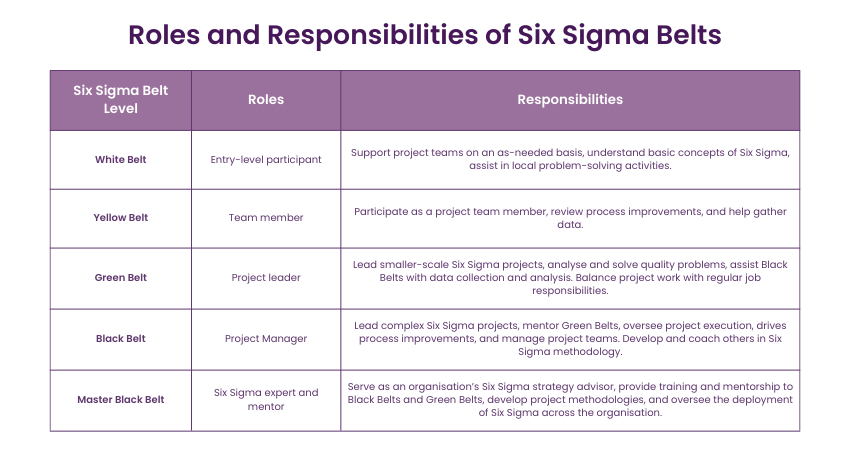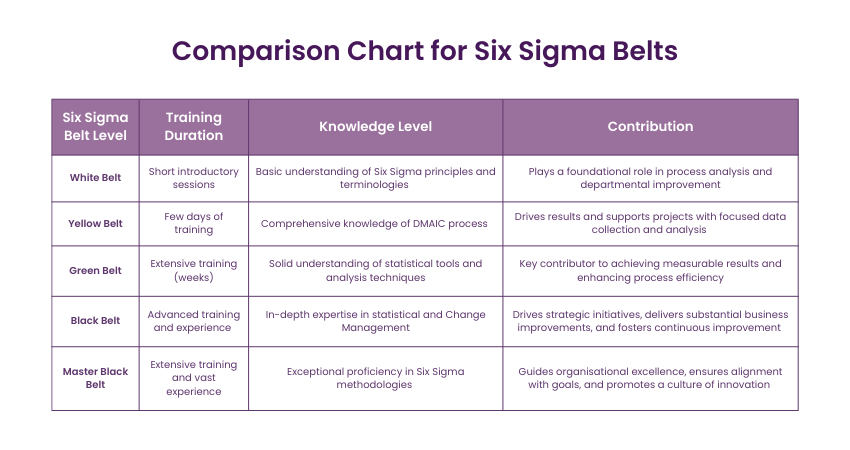We may not have the course you’re looking for. If you enquire or give us a call on + 1-866 272 8822 and speak to our training experts, we may still be able to help with your training requirements.
We ensure quality, budget-alignment, and timely delivery by our expert instructors.

Six Sigma makes process improvement an adventure marked by colourful belts and dynamic roles. Essentially, you can think of Six Sigma as a martial arts dojo for process improvement, with each belt representing a distinct set of skills, responsibilities, and contributions to achieving operational excellence.
This blog takes you through Six Sigma Belt levels, from the foundational white belt to advanced strategists wielding the black belt. So, read on, learn how Six Sigma turns chaos into clarity and elevate your career prospects!
Table of Contents
1) Overview of Six Sigma Belts
2) Six Sigma Belt Roles & Responsibilities
3) Understanding Six Sigma Belts and Their Levels
4) Six Sigma Belt Comparison Chart
5) Conclusion
Overview of Six Sigma Belts
The Belts in Six Sigma signify levels of expertise one possesses in Process Improvement methodologies. Starting with the entry-level ‘White Belt’, individuals progress through Yellow Belt, Green Belt, Black Belt, and finally, the Master Black Belt. Achieving higher Six Sigma belt levels can significantly enhance career prospects and earning potential, potentially leading to higher and increased job opportunities within various industries.
Each level represents enhanced levels of knowledge, skills, and leadership capabilities. Six Sigma Case Study examples can illustrate how different belt levels—White, Yellow, Green, Black, and Master Black Belts—contribute to project teams and lead process improvement efforts. These levels offer a structured framework for personal and organisational growth in Process Improvement.
Six Sigma Belt Roles & Responsibilities
The following table summarises the roles and responsibilities associated with the various Six Sigma Belt levels:

Ready to become certified? Grab the Six Sigma Green Belt Study Guide now!
Understanding Six Sigma Belts and Their Levels
Further, we will discuss each of the Six Sigma Belts in detail: 
1) White Belt
The White Belt level in Six Sigma represents the entry point into achieving the various Six Sigma Belts. Individuals with White Belt Certification possess a basic understanding of Six Sigma principles and terminologies. They support project teams, contribute to Process Improvement initiatives, and assist in data collection within their departments.
White Belts often undergo short training sessions introducing them to Six Sigma fundamentals. They learn to identify opportunities for improvement and play a crucial role in the initial stages of process analysis. Furthermore, while their contributions may be more limited than higher-level belts, White Belts serve as valuable team members, laying the foundation for their journey towards higher proficiency in Six Sigma.
2) Yellow Belt
The Yellow Belt level signifies a deeper level of involvement and knowledge in Six Sigma methodologies. Individuals with a Yellow Belt certification undergo more extensive training, often lasting a few days, to comprehensively understand the Define, Measure, Analyse, Improve, Control (DMAIC) process.
They actively participate in project teams working alongside Green Belts and Black Belts to gather data, analyse processes, and identify areas for improvement. Yellow Belts serve as essential contributors to the Six Sigma project, providing support throughout the project life cycle, a role frequently discussed in Lean Six Sigma Yellow Belt Exam Questions and Answers.
Moreover, they play a crucial role in data collection, analysis, and assisting in implementing improvement solutions. Adding Six Sigma to your resume as a Yellow Belt demonstrates your ability to drive measurable results. While their responsibilities may be more focused than higher-level belts, Yellow Belts still play a key role in fostering a culture of continuous improvement.
Master process improvement techniques and elevate your professional profile with our comprehensive Lean Six Sigma Certification Training - Sign up now!
3) Green Belt
The Green Belt level represents a significant step towards becoming a proficient Six Sigma practitioner. Individuals with a Green Belt certification possess a solid understanding of statistical tools and analysis techniques, allowing them to lead smaller process improvement projects within their departments. When comparing Lean Six Sigma Green Belt vs Scrum Master, both roles focus on process optimization, but the Green Belt is more centered on data-driven improvements, while the Scrum Master focuses on facilitating agile project management.

They work closely with Black Belts, providing valuable assistance in Data Analysis, Project Management, and the implementation of process enhancements within the framework of Six Sigma Quality Assurance. Green Belts actively participate in all phases of the DMAIC process, from defining project goals to monitoring and controlling improvements, ensuring adherence to Six Sigma Quality Assurance standards.
Their role involves conducting detailed Data Analysis, identifying root causes, and deploying effective solutions. Green Belts play a crucial role in driving continuous improvement and achieving measurable results within their organisations, often delivering significant cost savings and process efficiency enhancements. Assist with data collection and analysis by signing up for the Six Sigma Green Belt Training Course now!
4) Black Belt
The Black Belt level represents an advanced level of mastery in Six Sigma methodologies. Individuals with a Black Belt certification possess an in-depth understanding of Statistical Analysis, Project Management, and Change Management. They are responsible for leading and managing complex Process Improvement projects, often spanning multiple departments or organisational units.
Furthermore, Black Belts have the expertise to identify improvement opportunities, define project goals, mentor Green Belts and Yellow Belts, and deploy effective solutions. In the discussion of Lean Six Sigma Black Belt vs Six Sigma Black Belt, they work closely with top-level management to drive strategic initiatives and deliver substantial business benefits.
Moreover, Black Belts play a crucial role in implementing Six Sigma across the organisation, ensuring alignment with organisational goals and driving a culture of continuous improvement. Their leadership and analytical skills contribute to achieving breakthrough improvements and fostering sustainable change.
Gain a prolific Business Improvement insight by signing up for the Six Sigma Black Belt Course now!
5) Master Black Belt
The Master Black Belt level represents the highest level of expertise and experience in Six Sigma. Individuals with a Master Black Belt certification possess exceptional knowledge and proficiency in all aspects of Six Sigma methodologies. They serve as mentors, trainers, and coach Green Belts, Black Belts, and even senior leaders within the organisation.
Master Black Belts play a critical role in setting the strategic direction for Six Sigma implementation, ensuring alignment with organisational goals and objectives. They also oversee the selection and prioritisation of improvement projects, ensuring maximum impact and sustainability.
Furthermore, Master Black Belts guide and support the development of Six Sigma practitioners at all levels with their wealth of knowledge and experience. Their expertise contributes to driving significant Process Improvements, organisational excellence, and a culture of continuous learning and innovation.
Determine the correct strategy for your projects by signing up for the Six Sigma Master Black Belt Course now!
Six Sigma Belt Comparison Chart
Based on the previous section, here’s the comparison chart summarising the key distinctions between the various Six Sigma Belts:

Conclusion
This blog explores the Six Sigma Belts, from entry-level White Belt to Master Black Belt, outlining their roles in process improvement and leadership. Advancing through these levels helps professionals drive results, foster continuous improvement, and achieve significant business benefits, with the benefits of Lean Six Sigma Black Belt being particularly impactful in enhancing operational success.
Learn to eliminate defects through Business Improvement by signing up for Six Sigma Certification Training Courses now!
Frequently Asked Questions
Is Green Belt Six Sigma Worth it?

Lean Six Sigma Green Belt certification is certainly worth it. It is versatile, improves problem-solving skills, empowers process improvements, and opens new career opportunities.
Is a Six Sigma Black Belt Difficult?

Earning the Six Sigma Black Belt certification can be challenging. It requires an in-depth understanding of Six Sigma tools, methodologies, and their application. You'll need to master the Define, Measure, Analyse, Improve, Control (DMAIC) process and be able to lead complex improvement projects.
What are the Other Resources and Offers Provided by The Knowledge Academy?

The Knowledge Academy takes global learning to new heights, offering over 3,000 online courses across 490+ locations in 190+ countries. This expansive reach ensures accessibility and convenience for learners worldwide.
Alongside our diverse Online Course Catalogue, encompassing 19 major categories, we go the extra mile by providing a plethora of free educational Online Resources like News updates, Blogs, videos, webinars, and interview questions. Tailoring learning experiences further, professionals can maximise value with customisable Course Bundles of TKA.
What is The Knowledge Pass, and How Does it Work?

The Knowledge Academy’s Knowledge Pass, a prepaid voucher, adds another layer of flexibility, allowing course bookings over a 12-month period. Join us on a journey where education knows no bounds.
What are the Related Courses and Blogs Provided by The Knowledge Academy?

The Knowledge Academy offers various Six Sigma Certification Courses, including the Six Sigma Green Belt Training and the DMAIC Course. These courses cater to different skill levels, providing comprehensive insights into Lean Six Sigma Yellow Belt Benefits.
Our Business Improvement Blogs cover a range of topics related to Earned Value Management, offering valuable resources, best practices, and industry insights. Whether you are a beginner or looking to advance your business process improvement skills, The Knowledge Academy's diverse courses and informative blogs have got you covered.
Upcoming Business Improvement Resources Batches & Dates
Date
 Six Sigma Green Belt
Six Sigma Green Belt
Mon 19th May 2025
Mon 9th Jun 2025
Mon 21st Jul 2025
Mon 18th Aug 2025
Mon 15th Sep 2025
Mon 27th Oct 2025
Mon 17th Nov 2025
Mon 8th Dec 2025
Mon 19th Jan 2026
Mon 27th Apr 2026
Mon 21st Sep 2026
Mon 16th Nov 2026






 Top Rated Course
Top Rated Course



 If you wish to make any changes to your course, please
If you wish to make any changes to your course, please


